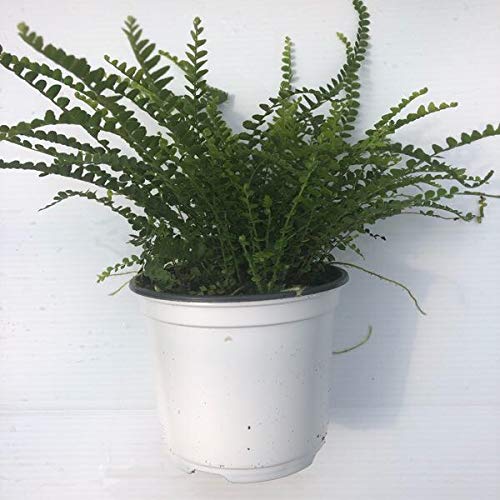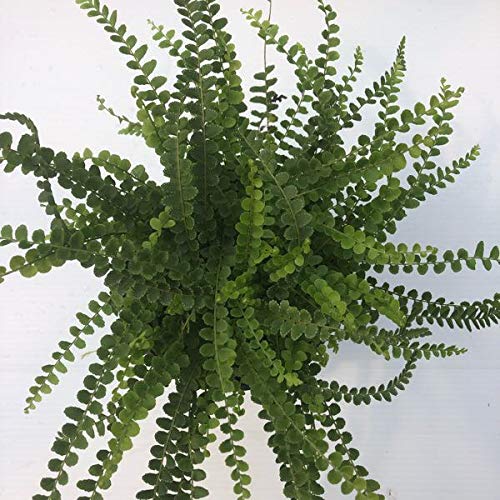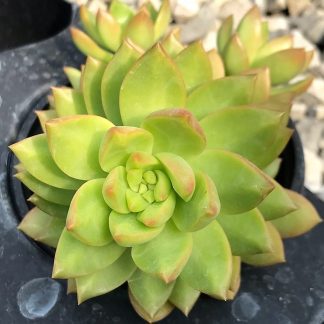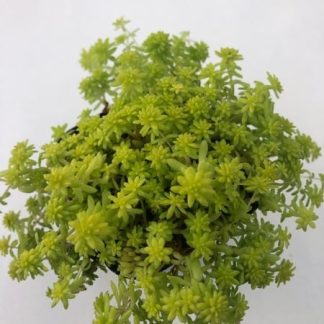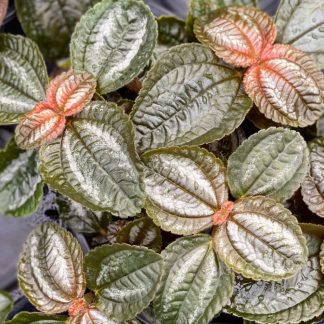Description
Lemon Button Fern: A Cheerful Houseplant for Fresh Green Vibes
Few plants brighten a room like the Lemon Button Fern. With its tiny, button-shaped fronds and soft lemony scent, this fern feels both playful and soothing. It works beautifully in small spaces, terrariums, or hanging baskets. Even better, it’s one of the easiest ferns to grow indoors or out.
This guide will explore what makes the Lemon Button Fern so special, how to care for it, and ways to enjoy its charm in your home or garden.
Meet the Lemon Button Fern
The Lemon Button Fern, or Nephrolepis cordifolia, belongs to the sword fern family. It is native to tropical and subtropical regions, thriving in warm, humid forests where it carpets the forest floor with soft green foliage.
Its name comes from two things: the rounded leaflets, which resemble tiny buttons, and the faint lemon fragrance that appears when the fronds are crushed or brushed against. This light citrus scent adds a fresh and uplifting note to indoor spaces.
Unlike larger ferns, this one stays compact—usually around 12 to 18 inches tall. Its fronds arch gracefully, making it perfect for tabletops, shelves, and small plant groupings.
Why Gardeners Love It
The Lemon Button Fern has gained popularity for many reasons.
Small and Versatile
Its petite size means it can fit anywhere—desks, windowsills, or even as a centerpiece in a mixed planter.
Easy-Care Nature
Compared to fussier ferns, this one adapts well to typical household conditions. While it loves humidity, it won’t wilt at the first sign of dry air.
Year-Round Color
It stays evergreen, bringing steady green beauty no matter the season.
Gentle Fragrance
The subtle lemon scent is refreshing and makes it stand out from other ferns.
Growing Conditions: What It Likes Best
To keep your Lemon Button Fern thriving, it helps to mimic its natural environment—a warm forest floor with indirect light, moist soil, and gentle humidity.
Light
Bright, indirect light is perfect. A north- or east-facing window is ideal. Too much direct sun can scorch the delicate fronds, while too little light may cause them to grow thin and sparse.
Outdoors, it thrives in partial shade. It can handle early morning sun but needs protection from harsh afternoon rays.
Temperature
This fern prefers temperatures between 60°F and 75°F. It can tolerate slightly cooler nights but should be protected from frost.
If grown outdoors in warm climates (zones 8–11), it can be planted in shaded garden beds or hanging baskets under trees. In cooler areas, treat it as a houseplant or bring it indoors for winter.
Humidity
Moderate to high humidity makes this plant happiest. Bathrooms and kitchens, with their naturally higher moisture levels, are excellent spots.
If your home is dry, try these tricks:
- Mist the plant lightly a few times a week.
- Place it on a pebble tray with water (without letting roots sit in water).
- Group it with other plants to create a humid microclimate.
Soil
A loose, well-draining potting mix is essential. Standard houseplant soil mixed with peat and perlite works well. The soil should stay slightly moist but never soggy.
If planted outdoors, ensure the soil is rich in organic matter and drains well to prevent root rot.
Watering Tips
Watering is where most fern lovers go wrong. The Lemon Button Fern likes consistently moist soil—but not waterlogged.
Here’s a simple rule:
- Water when the top inch of soil feels slightly dry.
- Water thoroughly until excess drains from the pot’s bottom.
- Empty any standing water from saucers to prevent rot.
During winter, reduce watering slightly but never let the soil fully dry out.
Fertilizing for Steady Growth
Ferns aren’t heavy feeders, but a little nutrition keeps them lush and vibrant. Use a balanced liquid fertilizer diluted to half strength every 4–6 weeks during spring and summer.
Skip fertilizing in winter when growth slows down.
Pruning and Grooming
Regular grooming keeps your fern looking fresh. Remove yellow or damaged fronds by cutting them close to the base. This encourages new growth and maintains a tidy shape.
Occasional trimming also helps the plant stay compact and full rather than leggy.
Repotting and Dividing
Lemon Button Ferns grow slowly, so they don’t need frequent repotting. Check every 2–3 years or when roots begin circling the pot.
When repotting:
- Gently remove the plant from its pot.
- Loosen the root ball and trim any dead roots.
- Place it in a slightly larger container with fresh soil.
You can also divide the plant during repotting. Simply separate sections of the root ball and plant each in its own pot. This is a great way to create extra plants for gifting or spreading around your home.
Common Problems and Solutions
Even easy ferns face occasional challenges. Here’s how to troubleshoot:
Browning Leaf Tips
Cause: Low humidity or inconsistent watering.
Solution: Increase humidity and keep soil evenly moist.
Yellowing Fronds
Cause: Overwatering or poor drainage.
Solution: Check soil moisture and ensure proper drainage.
Pests (like scale or mealybugs)
Cause: Indoor conditions with stagnant air.
Solution: Wipe fronds with a damp cloth and treat with insecticidal soap if needed.
Using Lemon Button Fern in Your Home
This fern’s charm lies in its versatility. It works as a solo statement or part of a lush arrangement. Here are a few ways to style it:
- Terrariums: Its small size and humidity love make it perfect for enclosed glass gardens.
- Hanging baskets: The arching fronds spill beautifully over the edges.
- Tabletop accents: Place on side tables, shelves, or bathroom counters for a pop of greenery.
- Mixed planters: Pair with other shade lovers like peperomia, pothos, or fittonia for a layered look.
Outdoor Landscaping Ideas
In frost-free zones, Lemon Button Fern makes an excellent groundcover in shaded gardens. It fills in under trees or along shaded pathways with soft, button-like fronds. It also works in rock gardens where it can nestle between stones in dappled light.
Its compact growth prevents it from overwhelming other plants, making it a gentle companion in mixed plantings.
Propagation: Create More Plants
The easiest way to propagate is by division. Here’s how:
- Water the plant well the day before.
- Remove it from the pot and gently shake off excess soil.
- Separate the root ball into smaller sections, ensuring each has healthy fronds and roots.
- Replant the divisions into fresh soil and water lightly.
With proper care, the new plants establish quickly and continue growing as if nothing happened.
Benefits Beyond Beauty
Beyond its good looks, the Lemon Button Fern offers several perks:
- Air Purification: Like many ferns, it helps clean indoor air by filtering toxins.
- Mood Boost: Its fresh scent and calming greenery create a soothing environment.
- Pet-Friendly: Safe for cats and dogs, making it a worry-free choice for pet owners.
Seasonal Care
Caring for this fern changes slightly with the seasons:
- Spring/Summer: Active growth. Water regularly, fertilize lightly, and enjoy its fullest foliage.
- Fall/Winter: Growth slows. Reduce watering slightly but maintain humidity and warmth. Protect from drafts.
Pairing with Other Plants
This fern pairs beautifully with other tropical and shade-loving plants. Good companions include:
- Fittonia (nerve plant) for color contrast.
- Calathea for bold patterned leaves.
- Pothos for trailing vines.
- Orchids for a refined tropical mix.
Together, they create lush mini jungles perfect for modern homes.
A Plant That Welcomes Beginners
What makes the Lemon Button Fern truly special is how forgiving it is. Many ferns intimidate beginners with their humidity and watering needs. But this one adapts easily to regular home conditions.
Its cheerful button fronds make every space feel a little fresher. It invites you to slow down, notice small details, and enjoy the quiet beauty of green life.
Embrace Its Cheerful Charm
The Lemon Button Fern is more than just another houseplant. It’s a bright, fragrant reminder of nature’s simple joys. Its button-like leaves and soft texture bring a sense of calm to any corner. And with just a little care—moderate light, steady moisture, and occasional grooming—it rewards you with year-round beauty.
If you’ve been searching for a plant that feels both easy and delightful, this might be the one. Whether in a tiny apartment, a sunny bathroom, or a shaded garden nook, the Lemon Button Fern fits right in.
A Gentle Green Friend for Every Space
Invite this little fern into your life. Watch its fronds unfurl, enjoy its soft lemon scent, and let it remind you of the quiet magic plants bring. In a world that moves fast, the Lemon Button Fern whispers a softer pace—a pace that feels like home.

